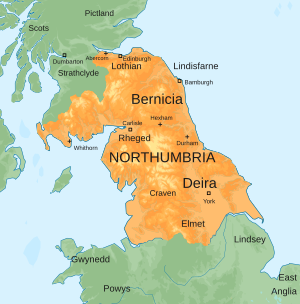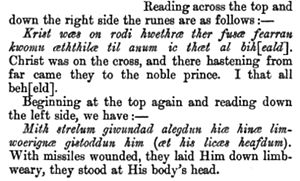Northumbrian Old English facts for kids
Northumbrian was an old way of speaking dialect of Old English. It was used in a part of England called Anglo-Saxon Northumbria. This area stretched from the Humber River in England to the Firth of Forth in Scotland. Northumbrian was one of four main types of Old English. The others were Mercian, Kentish, and West Saxon.
After the Vikings came, their language, Norse, started to mix with Northumbrian. This happened in the Danelaw area.
Some of the oldest writings in Old English are in Northumbrian. These include Caedmon's Hymn from the 600s and Bede's Death Song from the 700s. Other examples are the runes on the Ruthwell Cross. These runes are from the poem Dream of the Rood. The 800s Leiden Riddle and the 900s notes in the Lindisfarne Gospels are also in Northumbrian.
The Viking invasions split the Northumbrian dialect into two parts. South of the River Tees, the southern Northumbrian dialect mixed with Norse. But northern Northumbrian kept more Old English words. This northern dialect helped shape the modern ways of speaking in North East England and Scotland. Today, the Scots language comes from Northumbrian. So do the modern Northumbrian, Cumbrian, and Yorkshire dialects.
Contents
Exploring the History of Northumbrian Old English
Experts who study language history know about four main dialects of Old English. These were Northumbrian, Mercian, Kentish, and West Saxon. The Northumbrian dialect was spoken in the Kingdom of Northumbria. This kingdom covered a large area from the Humber River to the River Mersey in northern England. It also reached up to the Firth of Forth in Scotland.
Today, languages like Modern Scots, Northumbrian, and Cumbrian come directly from Northumbrian. Some dialects in Yorkshire also have Northumbrian roots. Northumbrian was quite different from other dialects. For example, it was very different from West Saxon. Modern Standard English, the English we speak today, mostly comes from the Mercian dialect.
The Angles brought their language, called Englisc, to Northumbria in the 500s AD. This language spread to what is now the Scottish Lowlands. This early form of Northumbrian Old English was first written down in poems. Examples include Cædmon's Hymn (around 658-680 AD) and writings by Bede (around 700 AD). The Leiden Riddle is another early example. The language also appears in the Lindisfarne Gospels (around 900 AD). In Scotland, you can find it as carved runes on the Ruthwell Cross (around 750 AD). Later, the Danes conquered Old Northumbria (867–883 AD). This led to the language being influenced by Old Norse.
The area of Lothian in Scotland was once part of England. Kenneth III of Scotland invaded it and made it part of Scotland. Even though the king spoke Scottish Gaelic, he let the people keep their Northumbrian dialect. It was still called Inglis back then. After the Battle of Carham, the area was split. The northern part went to Scotland, and the southern part stayed with England. The language north of this split later became known as Scottis or Scots.
Some old writers talked about how different Northumbrian was. The writer of the Northumbrian Cursor Mundi said that texts from southern England needed to be translated. This was so people in the north could understand them. Ralph Higden wrote in 1364 that Northumbrian was very hard for people from the south to understand. He thought this was because of the "strange men and nations" (meaning the Scots) living nearby. John of Trevisa also mentioned "strange men and aliens" when talking about northern English. Around 1440, Osbern Bokenam wrote about how Scots influenced northern English.
By the 1300s, Lowland Scots became the main language in Scotland's Lowlands. However, Northumbrian started to lose its importance in England by the 1500s. People in power, who lived in the south of England, thought Northumbrian words and accents were wrong. As England became more centralized in London, writings from the midland and southern dialects became the standard. Many letters, poems, and newspaper articles were written in Northumbrian and Cumbrian dialects in the 1800s and 1900s. But their use is now decreasing as Standard English becomes more common. Today, groups like the Northumbrian Language Society work to promote the modern Northumbrian dialect. The Lakeland Dialect Society does similar work for the Cumbrian dialect.
The Lord's Prayer in Old Northumbrian
Some people in Scotland and Northumbria still say /uːr ˈfeðər/ or /uːr ˈfɪðər/ for "our father". They also say [ðuː eːrt] for "thou art". The version of The Lord's Prayer below is from around 650 AD.
FADER USÆR ðu arð in heofnu
Sie gehalgad NOMA ÐIN.
Tocymeð RÍC ÐIN.
Sie WILLO ÐIN
suæ is in heofne and in eorðo.
HLAF USERNE of'wistlic sel ús todæg,
and f'gef us SCYLDA USRA,
suæ uoe f'gefon SCYLDGUM USUM.
And ne inlæd usih in costunge,
ah gefrig usich from yfle.
Bede's Death Song
Fore thaem neidfaerae ‖ naenig uuiurthit
thoncsnottura, ‖ than him tharf sie
to ymbhycggannae ‖ aer his hiniongae
huaet his gastae ‖ godaes aeththa yflaes
aefter deothdaege ‖ doemid uueorthae.
Cædmon's Hymn
Nū scylun hergan ‖ hefaenrīcaes Uard,
metudæs maecti ‖ end his mōdgidanc,
uerc Uuldurfadur, ‖ suē hē uundra gihwaes,
ēci dryctin ‖ ōr āstelidæ
hē ǣrist scōp ‖ aelda barnum
heben til hrōfe, ‖ hāleg scepen.
Thā middungeard ‖ moncynnæs Uard,
eci Dryctin, ‖ æfter tīadæ
firum foldu, ‖ Frēa allmectig.
The Leiden Riddle
Mec se uēta uong, uundrum frēorig,
ob his innaðae aerest cændæ.
Ni uaat ic mec biuorthæ uullan fliusum,
hērum ðerh hēhcraeft, hygiðonc....
Uundnae mē ni bīað ueflæ, ni ic uarp hafæ,
ni ðerih ðreatun giðraec ðrēt mē hlimmith,
ne mē hrūtendu hrīsil scelfath,
ni mec ōuana aam sceal cnyssa.
Uyrmas mec ni āuēfun uyrdi craeftum,
ðā ði geolu gōdueb geatum fraetuath.
Uil mec huethrae suae ðēh uīdæ ofaer eorðu
hātan mith hæliðum hyhtlic giuǣde;
ni anoegun ic mē aerigfaerae egsan brōgum,
ðēh ði n... ...n sīæ nīudlicae ob cocrum.
Ruthwell Cross Inscription
Krist wæs on rodi hwethræ ther fusæ fearran
kwomu æththilæ til anum ic thæt al bih[eald].
Mith strelum giwundad alegdun hiæ hinæ limwoerignæ
gistoddun him (æt his licæs heafdum).



